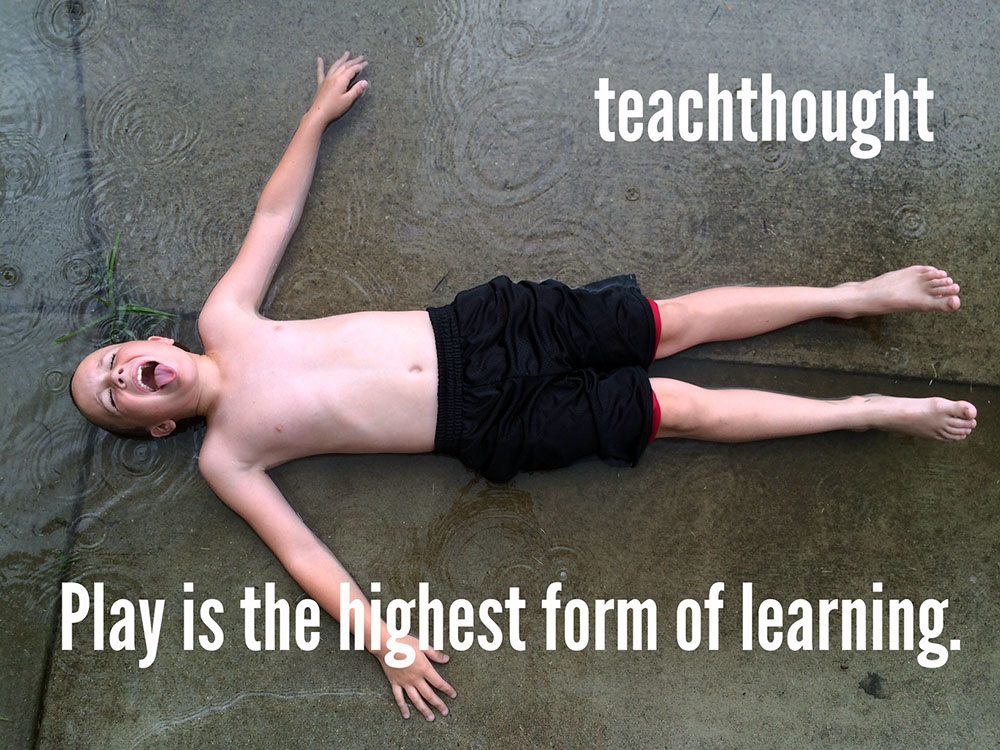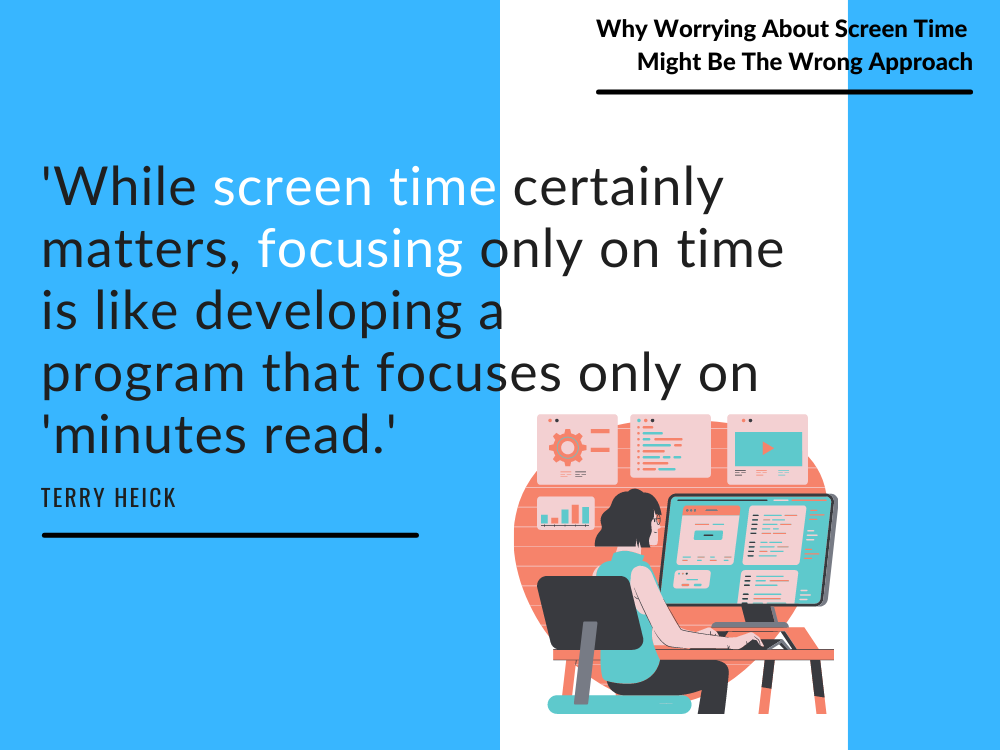Screen time.
Just the phrase tightens the chests of well-intentioned (and helicoptering) parents everywhere. Concerns range from our children becoming anti-social to developing addictions to certain games (I’m looking at you Fortnite), to screens preventing them from connecting with the physical spaces and people and opportunities around them.
As parents, we want balance, not necessarily because we know balance is best, but because we know that even if something is ultimately discovered to be terrible for the kids, we’ll be able to rest easy knowing they only had so much exposure. Balance is a kind of crude form of future-proofing –– we aren’t required to intricately understand the cause and effect of every factor; we can just recommend ‘balance’ and hope the factors we balance produce a healthy ecology.
The concept of ‘screen time’ exists in a world where screens are tools of identity, stages of curiosity and a constant need for information. Today, instead of each home having a single screen, it has five, and they’re mobile and do way, way more than televisions ever did. They blink and whir and update and multi-task and otherwise act as a user’s portal to the world.
Televisions were never this cool. In my home growing up, the primary screen time concern was sitting too close to the one television whose knobs you had to turn just to get Good Times or Knight Rider to come in properly. Do you want to be blind like your Uncle Dale? Scoot back, Mr Magoo.
The telephone was the dominant form of interpersonal communication, and VCRs were kind of forward-thinking. If someone had handed you a tablet or smartphone when you were 8, it would have blown your mind. For children today, though, stunning mobile technology is the new normal. Yet how, and how much, children should be engaging with this new normal are questions that have not, until now, been addressed with any nuance.
Back in 2011, the American Academy of Pediatrics released its recommendations for media use by children. The big idea, of course, is protecting children. In those earlier recommendations, AAP discouraged media use by any child younger than two years old. It said no to televisions in bedrooms. It warned about potential language delays in children watching television before their first birthday. It explained the need for ‘unstructured play time’ and learning ‘learning through play.’
And that was pretty much that. In 2013, AAP re-released the same guidelines, despite the fact that the iPad had been released three years earlier, and together with the smartphone revolution, had completely altered how users interact with digital media. Still, no changes.
Something finally got the AAP’s attention and pushed the group to take a longer look at its recommendations in the face of a culture increasingly fascinated with digital screens. As the organization rightly notes, “our policies must evolve or become obsolete.” But what requires evolving may, in the end, be less about time constraints for screens, and more about our perspective on how they help children learn.

What Is Play?
One of the mainstays in AAP’s recommendations over the years has been a call for ‘unstructured playtime,’ based on the idea that, “unstructured playtime stimulates creativity.” According to the group, parents should “prioritize daily unplugged playtime, especially for the very young.”
Fair enough–but it is also worth acknowledging that play comes in many forms. Play is a tone more than it is a specific activity. It centers the player, either as participant in a set of rules they agree to (like sport), or as the rule maker (kids inventing a game on a playground). Play is play because meaning is made in the mind of the player. And technology can provide endless opportunity for play, in part because of the characteristics of digital media.
Digital media have created a remix culture among users, where whimsy and idea sharing and memes and aliases and experimentation characterize every process and event. One of the greatest talents of digital media is to allow for unstructured play. The Sandbox, Minecraft, The Powder Game, The Sims, and dozens of other videos games and apps are designed as playspaces.
These are called ‘sandbox’ games, so named because they’re like a playground sandbox — a space for players to bring their own ideas. As in a real sandbox, there is less structure, and more possibility. Sandbox video games are filled with tools and possibilities, but leave the player to create their own experience. Any structure is there to promote creativity and experimentation. This is, undoubtedly, play.
Consider poet and naturalist Diane Ackerman’s definition of play in her wonderful book Deep Play. Ackerman explains:
“…play requires freedom. One chooses to play. Play’s rules may be enforced, but play is not like life’s other dramas. It happens outside ordinary life, and it requires freedom. But freedom alone doesn’t ensure a playful result…Players like to invent substitute worlds, more advantageous outcomes of events, supplemental versions of reality, other selves. Make-believe is at the heart of play, and also at the heart of much of what passes for work. Let’s make-believe we can shoot a rocket to the moon.”
While one doesn’t need a screen to imagine the moon, there is zero scientific evidence that suggests that screens mute one’s desire to go to the moon. Ackerman offers that when playing, “hallowed ground is usually outlined, so that it’s clearly set off from the rest of reality.” What could be more detached from the rest of reality than a colorful, digital facsimile–a blocky Minecraft world based only loosely on the rules and characteristics of the world around them, but close enough to make the user distinguish the rules between the two, and master each to their own advantage?
Our collective schema, as a culture, tends to see play as innocent, and technology as, at times, corrupting. We tend to visualize play as a child alone with blocks, mumbling as they talk themselves through a pretend event. Or maybe as a group of kids running in a field, or playing hide-and-seek. We’re a bit sentimental that way, and perhaps appropriately distrustful of the effect of anything new and poorly understood on our children—like technology. But all play events have built in rules and structure: A child “plays” hide-and-seek by participating in the rules. Same with tag, or blocks. They are both inspired and limited by the legacy of the game.
This is true of digital spaces as well; technology can be play.
The Transfer From Digital to Physical Spaces
Still, worrying about screen time is a legitimate concern. If children’s noses are pressed against little rectangular screens all day, their mindscape will be flooded with artifacts from the media consumed on those screens. They aren’t outside, connecting with their local community in the form of people or nature. They’re narrowing themselves, honing themselves for participation in a digital world, rather than the physical one that represents a fuller reality.
But as AAP seems to better understand today, the real question we should be asking is not just, how long are they watching? But also, what are they seeing? How is it affecting them? How does what they see challenge their existing beliefs? What sort of cognitive loads and higher order thinking skills do they volunteer themselves for with their online behavior? Do we want them being told a story from a book, or creating their own story in an digital universe where they’re in control? Which one more naturally creates thinking habits and behavioral shifts and skill acquisition that they can transfer to the real world?
These kinds of questions are notoriously difficult to understand and measure; it’s much easier to reduce our metrics to the most convenient one we can find: the ticking of a clock. But ultimately, the central issue regarding screens and children is less about the time they spend with them and more about the purpose and nuance of their digital interactions. I have a nephew who would rather play Fortnite than speak to any member of his family, exert himself physically, or create something with his hands. That worries me. This, though, has less to do with digital media, and more to do with the addictive nature of a single media form. Video games are designed to please. Not all media works that way.
As a means of addressing these issues, many educators have already called for a shift from consumption to production in the digital space–i.e., watch less, create more, starting in classrooms. Helping children understand how to transfer thinking and ideas from digital to physical spaces might also be a useful development. The more users can take ideas gained from idea expression (that is to say, a medium) into their physical context (IRL, or ‘in real life’), the more rational all the screen time seems.
But the best test we might have to evaluate the ‘appropriateness’ for any child in any situation might be, with a book, an app, a poem or a video game: “What are you doing, and why?” Citizenship is citizenship; digital citizenship can be considered a template for IRL Citizenship. While screen time certainly matters, focusing only on time is like developing a literacy program that focuses only on ‘minutes read.’
What about:
“What are you reading, and why?”
“What will you do with this reading experience?”
“What is reading doing to and for you?”
“What should you read or do next as a result?”
By modeling how and why people use digital media (e.g., to express ideas and connect with others), adults—parents, teachers, and family members alike—can help students think about the purpose of their behavior and the possibilities within their reach, and then consider those little glass interfaces in a more robust and authentic context. Then screen time becomes less of a problem, and more of a consumption strategy for a human being trying to understand the world.
Why Worrying About Screen Time Might Be The Wrong Approach

